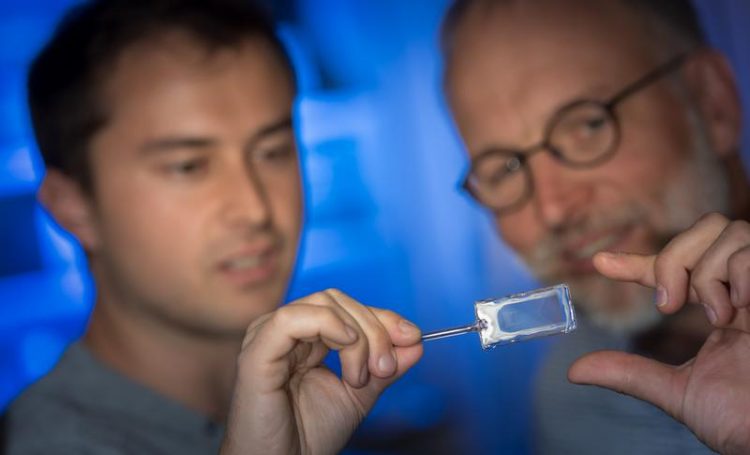First single-photon source that works with atomic gases at room temperature

Rubidium atoms are excited to their Rydberg states in a glass cell at room temperature. The volume between the glass plates is so thin that colored interference rings are visible to the naked eye. Universität Stuttgart/Max Kovalenko
A photon is the smallest conceivable amount of light. Classical light sources such as light bulbs or the sun emit many photons simultaneously, in random order. A single photon source on the other hand, emits only a single photon in a controlled way.
Such light sources have been known for about 20 years, but the various approaches (e.g. quantum dots or nitrogen defect centers in diamonds) are hot topics in research worldwide. The special feature of this new light source is that it can be operated without expensive cooling methods that need liquid gases or lasers.
The secret lies in the glass cell
The Stuttgart-based single-photon source works with atomic gases at room temperature for the first time. The secret lies in a credit card-sized glass cell filled with a vapor of rubidium atoms. The quantum character of the generated light is based on strong interactions between the individual atoms in the vapor cell. In order for the atoms to interact strongly, they are brought into highly excited Rydberg states by laser light.
These are states in which the outermost electron of each atom is particularly far away from the rest of the atom. Due to their enormous size, the interaction between two Rydberg atoms is very strong. A single Rydberg excitation does not allow another Rydberg atom in its vicinity and thus blocks the entire atomic cloud.
“Since the atoms are trapped in a microscopically small glass cell, only one Rydberg excitation can ever occur in this cell – no matter how many atoms are trapped in the cell,” explains Fabian Ripka, a PhD student at the 5th Institute of Physics at the University of Stuttgart. When this single excitation subsides again, a single quantum of light – a photon – is emitted. The Stuttgart researchers can specifically control the Rydberg excitation and the emission of the photon.
Individual photons already play an important role in quantum technology applications. Since they cannot be copied unnoticed, they are suitable, for example, for tap-proof quantum communication and are used in quantum cryptography. Prof. Tilman Pfau also sees great potential for single photons in so-called quantum computers. “In photonic networks, single-photon sources will be an essential component for performing quantum algorithms,” says the quantum physicist.
About IQST
The Center for Integrated Quantum Science and Technology IQST, a center for quantum sciences funded by the state of Baden-Württemberg, is a consortium of the Universities of Stuttgart and Ulm and the Max Planck Institute for Solid State Research in Stuttgart. The aim of the center is to promote synergies between physics and related natural and engineering sciences and to represent quantum science from the basics to technological applications.
Researchers at the 5th Physics Institute led by Prof. Tilman Pfau are investigating the quantum properties of atoms in the IQST and are trying to control them in a targeted way in their search for new states of matter or possible applications for quantum information technology and quantum optics.
Prof. Dr. Tilman Pfau, Universität Stuttgart, Tel.: +49 (0)711/685 64820, Mail: t.pfau@physik.uni-stuttgart.de
Fabian Ripka, Harald Kübler, Robert Löw, Tilman Pfau: A room-temperature single-photon source based on strongly interacting Rydberg atoms, Science from 26.10.2018, Vol. 362, Issue 6413, pp. 446-449, DOI: 10.1126/science.aau1949
Media Contact
More Information:
http://www.uni-stuttgart.de/All latest news from the category: Physics and Astronomy
This area deals with the fundamental laws and building blocks of nature and how they interact, the properties and the behavior of matter, and research into space and time and their structures.
innovations-report provides in-depth reports and articles on subjects such as astrophysics, laser technologies, nuclear, quantum, particle and solid-state physics, nanotechnologies, planetary research and findings (Mars, Venus) and developments related to the Hubble Telescope.
Newest articles

Trotting robots reveal emergence of animal gait transitions
A four-legged robot trained with machine learning by EPFL researchers has learned to avoid falls by spontaneously switching between walking, trotting, and pronking – a milestone for roboticists as well…

Innovation promises to prevent power pole-top fires
Engineers in Australia have found a new way to make power-pole insulators resistant to fire and electrical sparking, promising to prevent dangerous pole-top fires and reduce blackouts. Pole-top fires pose…

Possible alternative to antibiotics produced by bacteria
Antibacterial substance from staphylococci discovered with new mechanism of action against natural competitors. Many bacteria produce substances to gain an advantage over competitors in their highly competitive natural environment. Researchers…





















